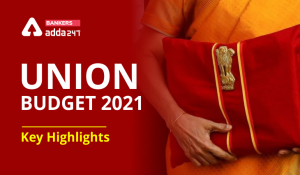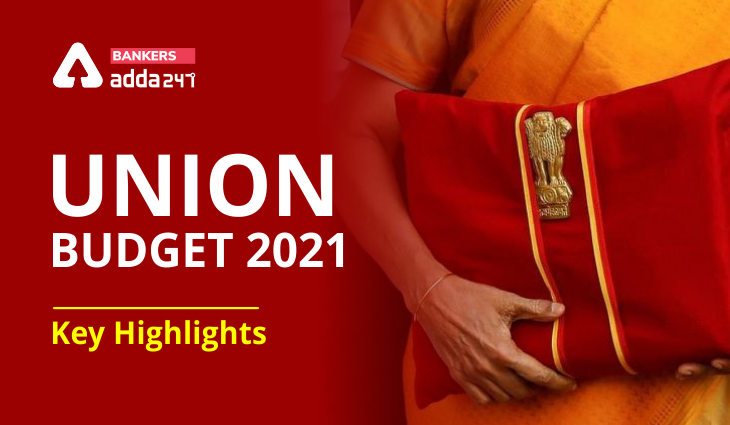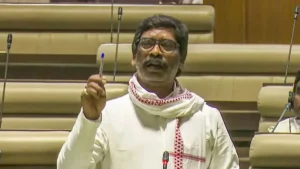
Union Finance Minister, Nirmala Sitharaman is presenting the Union Budget 2021 for the 3rd time in a row. The Union Budget is the yearly financial report estimating the income and expenditure presented to outline future policies to be adopted by the government for sustainable growth and development. The Economic Survey 2020-21 was released on 29th January 2021 by the Chief Economic Advisor of India, Krishnamurthy Subramanian. According to the survey, India’s economy could contract 7.7 per cent in the financial year that ends on March 31.
WARRIOR 5.0 Batch for SBI, RRB, RBI and IBPS Exams Banking Awareness Online Coaching | Bilingual
Finance minister Nirmala Sitharaman concluded her Budget speech at 12.50 pm. In February 2020, FM Nirmala Sitharaman spoke for a record 162 minutes — two hours and 42 minutes — in Lok Sabha. FM Sitharaman only had two pages of her Budget speech unread, when she appeared uneasy and her Budget speech was cut short.
Here are the key highlights from the Union Budget 2021-22:
- Total COVID-19 support measures amount to 13 per cent of GDP and total COVID-19 support measures by government and RBI amounts to Rs 27.1 lakh crore. The ‘Aatmanirbhar’ Packages accelerated India’s rate of reform.
- India has two COVID-19 vaccines available and we expect two more vaccines soon. India currently also has one of the lowest death rate and active cases in the world. India’s economic contraction is due to a global pandemic. The government is fully prepared to support and facilitate economic reset.
- Three times has a Budget followed contraction in the economy. Vision for Aatmanirbhar Bharat in Part-A of the Budget speech. ‘Aatmanirbharta’ consists of doubling farm income and strong infrastructure. It consists of good governance and women empowerment. Proposals for the FY22 Budget rests on 6 pillars.
- First of six pillars Aatmanirbhar Yojana in addition to the National Health Mission introduce the Aatmanirbhar Health Yojana with an outlay of Rs 64,180 crore over six years. This will strengthen the National Centre for Disease Control. Besides this, the government will also set up 15 Health Emergency Centres.
- Jal Jeevan Mission with an outlay of Rs 2.87 lakh crore to cover houses and to be implemented over five years. Budget 2021 will also launch Mission Poshan 2.0. Besides this, the launch of urban ‘Swacch Bharat Mission’ 2.0 with an outlay of Rs 1.42 lakh crore has been made.
- Finance Minister Nirmala Sitharaman has announced voluntary vehicle scrapping policy. Vehicles to undergo fitness test – which is 20 years for passenger vehicles and 15 years for commercial vehicles. Further details of the scrappage policy to be announced shortly.
- Fitness testing for both PVs and CVs a positive move to create not only employment opportunities but a move that will ensure a cleaner environment as part of the Health Infrastructure pillar. This will also boost demand for more cleaner vehicles.
- The government has set an ambitious target of building infrastructure in the country. But funding these infrastructure projects would have posed a steep challenge because of the revenue constraints and the stress on the loan books of banks. FM Sitharaman is likely to announce a dedicated development financial institution to facilitate the financing of greenfield infrastructure projects.
- Rs 35,000 crore to be allocated for further funds for COVID-19 vaccines. we will provide more for COVID-19 vaccines if required. The private sector may be kept out of vaccination efforts it appears, a disappointment for them. At a blended cost of Rs255/dose (in the first phase), that will cover 2 doses of the vaccine for 68.6crore people in FY22.
- Government has committed Rs 1.97 lakh crore for Production Linked Incentive Scheme (PLI) covering 13 sectors. Further, 7 textile parks will be launched for over three years.
- National Infrastructure Pipeline has been expanded to 7,400 projects. Further, projects worth Rs 1.1 lakh crore have been completed under the National Infra Pipeline. The government will also introduce a bill to set up DFI providing Rs 20,000 crore to launch the National Asset Monetisation Pipeline to fund new infra projects.
- The FM has announced that a Bill will be introduced to set up a DFI or developmental financial institution to fund long-term infra projects with a capital of Rs 20,000 crore. Rs 5 lakh crore will be lent by DFI in three years time.
- An asset monetisation dashboard will be created to provide clarity to investors. For 2021-22; capital expenditure is seen at Rs 5.54 lakh crore which is up by 34.5 per cent year-on-year (YoY).
- NHAI has sponsored one InVit to attract investors. Thus 5 operational roads with Rs 5,000 crore value being transferred to NHAI InVit. NHAI operational roll roads are to be monetised.
- Meanwhile, Railways will monetise dedicated freight corridors after commissioning. The next lot of airports will also be monetised for operations and management. AAI airports in tier-2,3 cities and other railway assets are to be monetised.
- Amendment in InvIT and REIT structures for debt investors will ease fundraising and will provide the momentum to the commercial real estate asset class.
- More than 13,000 km of roads awarded under Bharat Mala project. Around 3,800 km have been constructed in Bharatmala so far and 8,500 km to be awarded by March 2022. Will complete additional 11,000 km of NH corridor by March 2022. More economic corridors are being planned – 3,500 km of NH works are ongoing in Tamil Nadu.
- Power transmission assets of Rs 7,000 crore is to be transferred to Power Grid InvIT. The Centre will also provide Rs 2 lakh crore to states and autonomous bodies for Capex. We will nudge states for more capital expenditure. FY22 Capex has targetted at Rs 5.54 lakh crore v/s FY21’s Rs 4.39 lakh crore. The alternatives will be worked out so that consumers could choose from more than one power distribution companies. It’s a positive for Tata Power.
- Bloomberg reports that fiscal deficit will be 9.8 per cent of the GDP for FY21 and 6.8 per cent for FY22.
- The government will allot Rs 1.03 lakh crore for National Highway Projects in Tamil Nadu; Rs 65,000 core for National Highway Projects in Kerala; Rs 25,000 crore for National Highway Projects in West Bengal.
- The Eastern Freight Corridor is to be taken up this year via PPP mode. Further, three future dedicated freight corridors — East Coast, East-west, North-south are in works. These will have an automatic system on high-density rail routes to avoid collisions. Complete, 100% electrification of broad-gauge rail routes will be done by December 2023.
- Proposed to update the definition of small companies to be raised up to rs crore from Rs 50 lakh net worth.
- Rs 2,217 crore for 42 urban centres with a million-plus population, to tackle the burgeoning problem of air pollution.
- Supplementary Nutrition Programme and POSHAN Abhiyaan to be merged, Mission POSHAN 2.0 to be launched, To strengthen nutritional content, delivery and outcome, Intensified strategy for improving nutritional outcomes in aspirational districts.
- In Budget 2021, Union Finance Minister Nirmala Sitharaman has announced Rs 1.1 lakh crore for Indian Railways.
- A record Rs 1,10,055 crore has been provided for Indian Railways. Out of the total, Rs 1,07,100 crore will be provided for capital expenditure in 2021-22, says FM Nirmala Sitharaman.
- The government plans to sell part of its holding in Life Insurance Corporation of India through an initial public offering in the coming year. An amendment to the existing Act to facilitate the public offer, says FM Nirmala Sitharaman.
- The government plans to further strengthen the NCLT framework and continue with the e-court system for faster resolution of bad debts. A separate framework for MSMSe will also be made by the government.
- Strategic disinvestment of companies including BPCL, Air India, Pawan Hans, IDBI Bank, Container Corporation of India to be completed in 2021-22, Sitharaman has announced. The government will ask Niti Aayog to start working on identifying the next list of companies for strategic sale.
- FM announces further infusion of Rs 20,000 crore for public sector banks.
- FDI in insurance sector proposed to be hiked to 74% from 49% now.
- Rs 1,000 crore to solar energy corporation and Rs 1,500 to renewable energy development agency.
- Finance Minister Nirmala Sitharaman announces a new gas pipeline project for Jammu and Kashmir.
- Centre to provide Rs 18,000 crore for public buses, announces FM.
- FM Sitharaman proposes an increase in agriculture credit target to Rs 16.5 lakh crore. “The MSP regime has undergone a change to assure price that is at least 1.5 times the cost of production across all commodities. The total amount paid to paddy farmers surged to Rs 1.72 lakh crore in 2020-21.”
- The government has announced the extension of benefits of the Ujjawala scheme to an additional 1 crore people. The scheme, which provides LPG connections with financial assistance from the central government and currently benefits 12 crore households, will be extended further to provide clean cheap cooking fuel.
- The government has announced an independent gas transport system operator for booking and coordination to ensure for unbiased allocation of natural gas transportation capacity. The government aims to address concerns of bias in the allocation of gas transportation capacity by players such as Gail involved in both the supply and transportation of natural gas.
- FM says the definition of small companies to be revised by raising the capital base to Rs 2 cr from the current limit of Rs 50 lakh.
- FM puts disinvestment receipts at Rs 1.75 lakh cr for the fiscal year beginning April 1, 2021. Two PSBs and one general insurance company to be divested, legislations amendments to be introduced in this session.
- The government has allocated close to Rs 3.60 lakh crore in the Budget towards launching a “revamped”, reforms-based, result-linked power distribution sector scheme.
- National Education Policy got a good reception, FM said. “Over 15,000 schools to be qualitatively strengthened under the National Education Policy.
- Finance Minister Nirmala Sitharaman earmarks Rs 1,500 crore for promoting a digital mode of payment.
- Finance Minister Nirmala Sitharaman announced an allocation of Rs 300 crore to the state of Goa for celebrating the 60th anniversary of the liberation from Portuguese rule.
- Social security benefits to be extended to gig and platform workers. Minimum wages will apply to all categories of workers and will be covered under ESIC. This will impact around 15 million gig workers in India, in addition to online platform providers across sectors such as transportation (Uber and Ola), food delivery (Swiggy and Zomato), and the contract workers in IT and software firms.
- FM announces a special scheme for the welfare of women and children in Assam and West Bengal. Rs 1,000 crore for Bengal, Assam tea workers.
- Fiscal deficit estimated at 9.5% of GDP for 2020-21. Fiscal deficit for 2021-22 at 6.8% of GDP.
- Forthcoming Census could be India’s first digital Census, says Sitharaman allocating Rs 3,768 crore for FY-21.
- Allocation to rural infra development increased to Rs 40,000 cr in next fiscal from Rs 30,000 crore in FY21.
- FM announces development of 5 major fishing hubs.
- 1,000 more mandis will be integrated with the electronic national market.
- Central University to be set up in Leh, Ladakh.
- Operation green scheme to cover 22 more perishable commodities.
- Social security benefits will be extended to gig and platform workers. Minimum wages will apply to all categories of workers. Women will be allowed to work in all categories and also in night shifts with adequate protection. To further extend efforts towards unorganised labour force, I propose to launch a portal to collect relevant information on gig workers, building/construction workers among others. It’ll help formulate health, housing, skill, insurance credit &food schemes for migrant workers.
- Non-resident individuals with entrepreneurial potential are now enabled to set up One Person Companies (OPC) with no paid-up capital and turnover restrictions, reducing registration timeline from 182 days to120 days. Earlier only Indian resident citizens were permitted to set up OPCs. This would be attractive to the Indian Diaspora.
- In the 75th year of Independence of our country, we shall reduce the compliance burden on senior citizens. For senior citizens who only have a pension and interest income, I propose exemption of filing of income tax returns: FM
- In serious tax evasion cases, only where there is evidence of concealment of income of Rs 50 lakh or more in a year, can reassessment be opened for 10 years. For others, assessment reopening only for 3 years.
- NRIs to be spared from double taxation. New rules to be notified. Tax audit limit increased from Rs 5 crore to Rs 10 crore.
- Govt proposes setting up of a conciliatory mechanism for quick resolution of contractual disputes.
- Govt proposes to introduce the National Nursing and Midwifery Commission Bill.
- Govt proposes national language translation initiative.
- Govt proposes deep ocean mission with an outlay of more than Rs 4,000 cr over five years.
- The government has given relief measures for senior citizens by removing the need to file income tax returns for those aged over 75 years. It has also announced a halving of the time frame for reopening of income-tax assessment cases from 6 years to 3 years. For reopening of serious tax evasion cases up to 10 years, the government has put in a monetary limit of cases involving over Rs 50 lakh in a year. This is expected to reduce instances of tax harassment of income taxpayers.
- Late deposit of employee’s contribution to PF by employers will not be allowed as a deduction to the employer.
- Tax holiday for start-ups increased by one more year – till March 31, 2022.
- NRIs allowed operating One Person Companies or OPCs in India.
- Tax exemption for aircraft leasing company may finally see India getting its first player in this aviation segment. Till now, the Indian aviation industry is dominated by lessors from Ireland and Hong Kong.
- Customs duty on copper scrap cut to 2.5 per cent. Customs duty on some auto parts to be raised to 15 per cent.”
- No deduction to employers for late deposit of employee contribution to Provident Fund.
- To extend eligibility for startups to claim tax holiday by 1 year.
- Nifty Metal index drops by nearly 2 per cent from its top as custom duties on steel and copper are reduced.
- Easing Compliance requirements of Small Companies – Threshold increased to Share Capital up to Rs.2 crore and Turnover up to Rs.20 crore will be Small Companies.
- National Language Translation Mission will be set up to boost regional languages and translation for our regional speakers. This will phenomenally help in increasing the utilisation of internet services and augment the vision of digital India!.
- 100 new Sainik #schools will be set up in partnership with the NGOs, private schools and States.
- Exemption duty on steel scrap up to March 2022; customs duty on naphtha cut to 2.5 pc: FM
- Rationalising customs duties on gold and silver says FM in Budget for 2021-22
- Customs duty on cotton increased to 10%, silk to 15%
- Customs duty on solar lanterns cut to 5%.
- The Finance minister surprised taxpayers by not announcing any change in income tax slab rates. Some relief in filing ITR for senior citizens above 75. No Covid tax, surcharges on income tax.
Summary of the Budget 2021-22:
PART-A
The Budget proposals for 2021-2022 rest on 6 pillars.
i. Health and Wellbeing
ii. Physical & Financial Capital, and Infrastructure
iii. Inclusive Development for Aspirational India
iv. Reinvigorating Human Capital
v. Innovation and R&D
vi. Minimum Government and Maximum Governance
i. Health and Wellbeing
- Vaccines
- Nutrition
- Universal Coverage of Water Supply and Swachch Bharat Mission
ii. Physical & Financial Capital, and Infrastructure
- AatmaNirbhar Bharat-Production Linked Incentive Scheme
- Textiles
- Infrastructure
- Infrastructure financing – Development Financial Institution (DFI)
- Asset Monetisation
- Roads and Highways Infrastructure
- Railway Infrastructure
- Urban Infrastructure
- Power Infrastructure
- Ports, Shipping, Waterways
- Petroleum & Natural Gas
- Financial Capital
- Increasing FDI in Insurance Sector
- Disinvestment and Strategic Sale
iii. Inclusive Development for Aspirational India
- Agriculture
- Fisheries
- Migrant Workers and Labourers
- Financial Inclusion
iv. Reinvigorating Human Capital
- Scheduled Castes and Scheduled Tribes Welfare
- Skilling
v. Innovation and R&D
The Finance Minister said that in her Budget Speech of July 2019, She had announced the National Research Foundation and added that the NRF outlay will be of Rs. 50,000 crore, over 5 years. It will ensure that the overall research ecosystem of the country is strengthened with focus on identified national-priority thrust areas.
vi. Minimum Government, Maximum Governance
- Measures being undertaken to bring reforms in Tribunals to ensure speedy justice
- National Commission for Allied Healthcare Professionals already introduced to ensure transparent and efficient regulation of the 56 allied healthcare professions
- The National Nursing and Midwifery Commission Bill introduced for the same in nursing profession
- Proposed Conciliation Mechanism with mandate for quick resolution of contractual disputes with CPSEs
- Rs. 3,768 crore allocated for first digital census in the history of India
- Rs. 300 crore grant to the Government of Goa for the diamond jubilee celebrations of the state’s liberation from Portuguese
- Rs. 1,000 crore for the welfare of Tea workers especially women and their children in Assam and West Bengal through a special scheme
Fifteenth Finance Commission:
- The final report covering 2021-26 was submitted to the President, retaining vertical shares of states at 41%
- Funds to UTs of Jammu and Kashmir and Ladakh would be provided by Centre
- On the Commission’s recommendation, Rs. 1,18,452 crore have been provided as Revenue Deficit Grant to 17 states in 2021-22, as against Rs. 74,340 crore to 14 states in 2020-21
Part-B
- Direct Taxes
Achievements:
- Corporate tax rate slashed to make it among the lowest in the world
- Burden of taxation on small taxpayers eased by increasing rebates
- Return filers almost doubled to 6.48 crore in 2020 from 3.31 crore in 2014
- Faceless Assessment and Faceless Appeal introduced
Relief to Senior Citizens:
Exemption from filing tax returns for senior citizens over 75 years of age and having only pension and interest income; tax to be deducted by paying bank
Reducing Disputes, Simplifying Settlement:
- Time limit for re-opening cases reduced to 3 years from 6 years
- Serious tax evasion cases, with evidence of concealment of income of Rs. 50 lakh or more in a year, to be re-opened only up to 10 years, with approval of the Principal Chief Commissioner
- Dispute Resolution Committee to be set up for taxpayers with taxable income up to Rs. 50 lakh and disputed income up to Rs. 10 lakh
- National Faceless Income Tax Appellate Tribunal Centre to be established
- Over 1 lakh taxpayers opted to settle tax disputes of over Rs. 85,000 crore through Vivad Se Vishwas Scheme until 30th January 2021
Relaxation to NRIs:
- Rules to be notified for removing hardships faced by NRIs regarding their foreign retirement accounts
Incentivising Digital Economy:
- Limit of turnover for tax audit increased to Rs. 10 crore from Rs. 5 crore for entities carrying out 95% transactions digitally
Relief for Dividend:
- Dividend payment to REIT/ InvIT exempt from TDS
- Advance tax liability on dividend income only after declaration/ payment of dividend
- Deduction of tax on dividend income at lower treaty rate for Foreign Portfolio Investors
Attracting Foreign Investment for Infrastructure:
- Infrastructure Debt Funds made eligible to raise funds by issuing Zero-Coupon Bonds
- Relaxation of some conditions relating to prohibition on private funding, restriction on commercial activities, and direct investment
Supporting ‘Housing for All’:
- Additional deduction of interest, up to Rs. 1.5 lakh, for loan taken to buy an affordable house extended for loans taken till March 2022
- Tax holiday for Affordable Housing projects extended till March 2022
- Tax exemption allowed for notified Affordable Rental Housing Projects
Tax incentives to IFSC in GIFT City:
- Tax holiday for capital gains from incomes of aircraft leasing companies
- Tax exemptions for aircraft lease rentals paid to foreign lessors
- Tax incentive for relocating foreign funds in the IFSC
- Tax exemption to investment division of foreign banks located in IFSC
Ease of Filing Taxes:
- Details of capital gains from listed securities, dividend income, interest from banks, etc. to be pre-filled in returns
Relief to Small Trusts:
- Exemption limit of annual receipt revised from ₹1 crore to ₹5 crore for small charitable trusts running schools and hospitals
Labour Welfare:
- Late deposit of employee’s contribution by the employer not to be allowed as deduction to the employer
- Eligibility for tax holiday claim for start-ups extended by one more year
- Capital gains exemption for investment in start-ups extended till 31st March, 2022
- Indirect Taxes
GST: Measures were taken to date:
- Nil return through SMS
- A quarterly return and monthly payment for small taxpayers
- Electronic invoice system
- The validated input tax statement
- Pre-filled editable GST return
- Staggering of returns filing
- Enhancement of capacity of GSTN system
- Use of deep analytics and AI to identify tax evaders
Custom Duty Rationalization:
- Twin objectives: Promoting domestic manufacturing and helping India get onto global value chain and export better
- 80 outdated exemptions already eliminated
- Revised, distortion-free customs duty structure to be put in place from 1st October 2021 by reviewing more than 400 old exemptions
- New customs duty exemptions to have validity up to the 31st March following two years from its issue date
Electronic and Mobile Phone Industry:
- Some exemptions on parts of chargers and sub-parts of mobiles withdrawn
- Duty on some parts of mobiles revised to 2.5% from ‘nil’ rate
Iron and Steel:
- Customs duty reduced uniformly to 7.5% on semis, flat, and long products of non-alloy, alloy, and stainless steels
- Duty on steel scrap exempted up to 31st March, 2022
- Anti-Dumping Duty (ADD) and Counter-Veiling Duty (CVD) revoked on certain steel products
- Duty on copper scrap reduced from 5% to 2.5%
Textiles:
- Basic Customs Duty (BCD) on caprolactam, nylon chips and nylon fiber & yarn reduced to 5%
Chemicals:
- Calibrated customs duty rates on chemicals to encourage domestic value addition and to remove inversions
- Duty on Naptha reduced to 2.5%
Gold and Silver:
- Custom duty on gold and silver to be rationalized
Renewable Energy:
- Phased manufacturing plan for solar cells and solar panels to be notified
- Duty on solar invertors raised from 5% to 20%, and on solar lanterns from 5% to 15% to encourage domestic production
Capital Equipment:
- Tunnel boring machine to now attract a customs duty of 7.5%; and its parts a duty of 2.5%
- Duty on certain auto parts increased to general rate of 15%
MSME Products:
- Duty on steel screws and plastic builder wares increased to 15%
- Prawn feed to attract customs duty of 15% from earlier rate of 5%
- Exemption on import of duty-free items rationalized to incentivize exporters of garments, leather, and handicraft items
- Exemption on imports of certain kind of leathers withdrawn
- Customs duty on finished synthetic gem stones raised to encourage domestic processing
Agriculture Products:
- Customs duty on cotton increased from nil to 10% and on raw silk and silk yarn from 10% to 15%.
- Withdrawal of end-use based concession on denatured ethyl alcohol
- Agriculture Infrastructure and Development Cess (AIDC) on a small number of items
Rationalization of Procedures and Easing of Compliance:
- Turant Customs initiative, a Faceless, Paperless, and Contactless Customs measures
- New procedure for administration of Rules of Origin




 Exercise Desert Cyclone II Begins: India...
Exercise Desert Cyclone II Begins: India...
 Jharkhand Clears Landmark Law for Gig Wo...
Jharkhand Clears Landmark Law for Gig Wo...
 Which Fish is known as the King of India...
Which Fish is known as the King of India...







